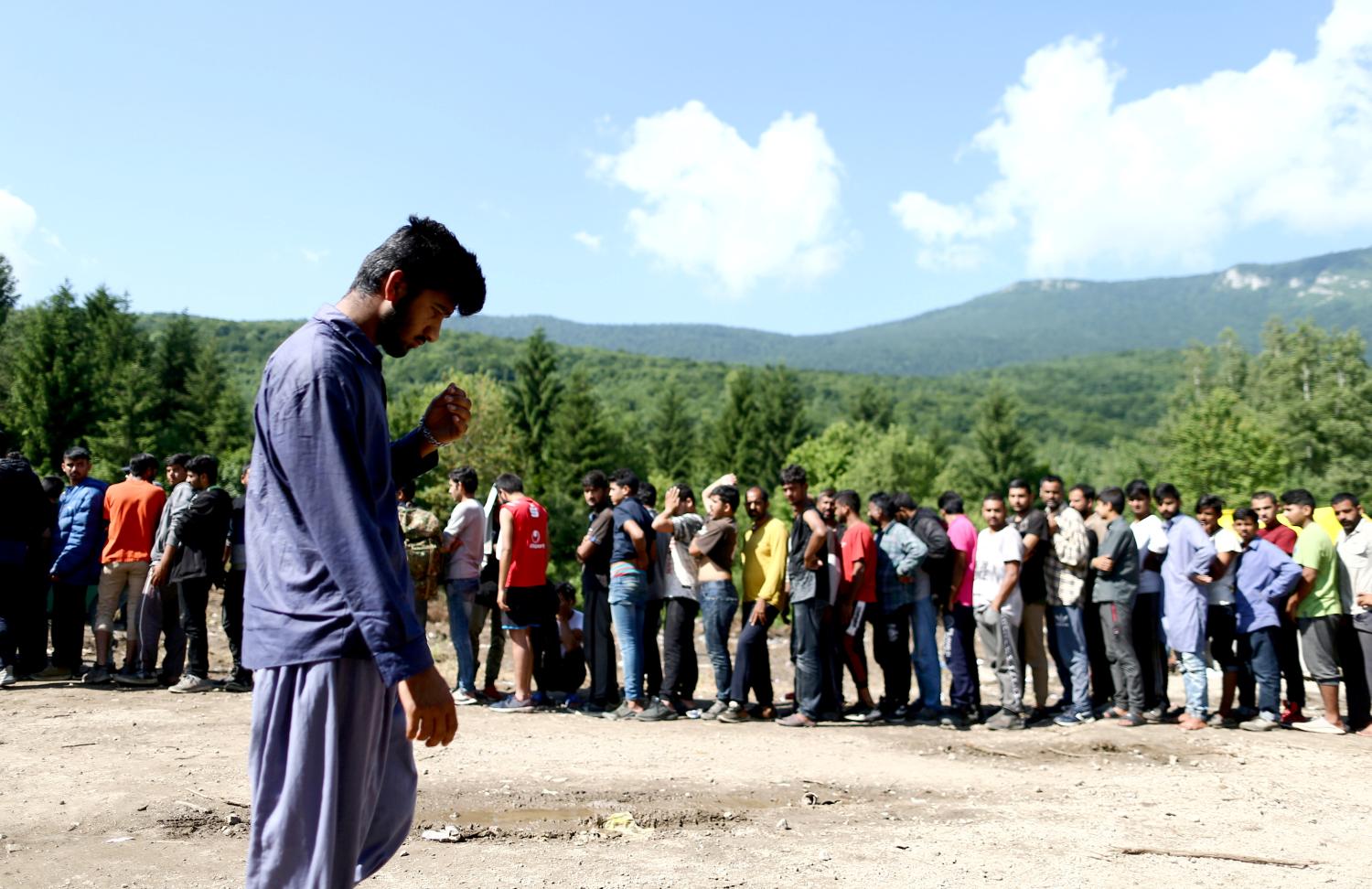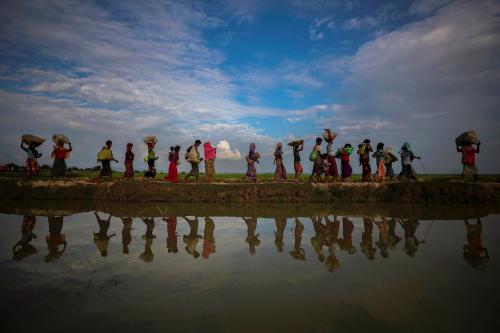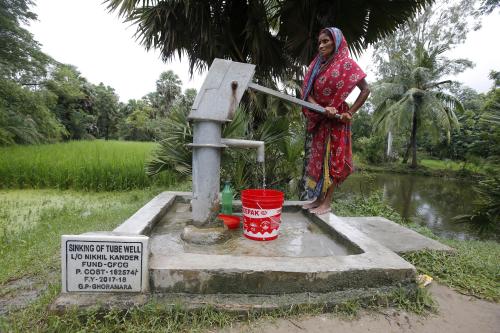The following is one of eight briefs commissioned for the 16th annual Brookings Blum Roundtable, “2020 and beyond: Maintaining the bipartisan narrative on US global development.”
The stubborn challenge of fragility continues to drive a host of obstacles to global peace and prosperity. The 2018 OECD “States of Fragility” report calculates that the number of people living in fragile contexts will grow from 1.8 billion in 2018 to 2.3 billion in 2030.1 While poverty continues to fall everywhere else around the world, fragile states are projected to be home to 80 percent of those living in extreme poverty by 2030.2
Moreover, fragility also serves as the common denominator in rising global trends in violent conflict, pandemics, and forced migration and refugees. Violent extremists have exploited fragile regions and conflict zones, spreading to 19 of the 45 countries that make up the Sahel, Horn of Africa, and Middle East, sowing further instability and undermining already fragile states.3
As a result, the challenge of state fragility is now being viewed as both a global security threat and the principal obstacle to achieving the 2030 Sustainable Development Goals (SDGs). The success of current approaches to helping countries move beyond fragility has been limited, including too often outright failure. In the face of this frustration, a consensus is emerging among policymakers for the need to align across development, humanitarian, diplomatic, and security sectors to unlock potential solutions and speed efforts at effective action.
In the past year alone, important initiatives have been undertaken in the U.S. by the administration, the Congress, and civil society, complementing similar initiatives in the U.K., the EU, the United Nations, and the World Bank. The urgent next step will be to build off this consolidation and alignment and convert growing political will into support for the effective implementation of new approaches.
US administration
In 2018, the Departments of State and Defense and the U.S. Agency for International Development (USAID) issued a “Stabilization Assistance Review.”4 The policy statement calls for an integrated civilian-military approach to building stability, supporting local actors based on inclusive political structures and basic security, and with flexible and adaptable programming. It sets out a series of principles to guide U.S. engagement. The Department of State and USAID are following up with a “Strategic Prevention Project,” designed to identify the components of an approach to prevent fragile situations evolving into conflict and extremism. Emphasis is placed on social cohesion, political inclusion, and locally-driven reform.
US Institute of Peace
Senator Lindsay Graham (R-SC) inserted into the FY2017 foreign operations bill a provision to fund the U.S. Institute for Peace (USIP) to develop a comprehensive plan to address the underlying causes of extremism in fragile states in the Sahel, Horn of Africa, and the Near East. The subsequent Task Force on Extremism in Fragile States, chaired by former Congressman Lee Hamilton and former Governor Thomas Kean, published its report in February 2019.5
The focus of the report is on prevention, which is a challenge to the current reactive U.S. policies and practices. The report is premised on the assessment that after spending $6 trillion since 9/11, the emphasis on security and kinetic approaches has fallen short, with more than twice as many Salafist-jihadi groups today in the Middle East, Sahel, and Horn of Africa than in 2001. A prevention strategy that aligns diplomatic, development, and security efforts is essential to address the core conditions of fragility more effectively. The report makes three principal recommendations: adopt a shared framework for strategic prevention, establish a strategic prevention initiative, and leverage international resources and coordination through a Partnership Development Fund.
The shared framework would be based on an understanding that an approach to addressing the root causes of extremism and fragility must be centered on promoting political inclusion and lead roles for local reformers (at the national and local levels), with external supporters playing empowering and supporting roles. The framework should encompass inclusive institutions, including women and youth, accountable governance, and civic participation.
The strategic prevention initiative involves alignment of U.S. government authorities and procedures through assigning clear roles and responsibilities, with the Congress providing more flexible funding authorities that allow adaptive, iterative approaches over longer periods.
The Partnership Development Fund would be a new arrangement to align and secure international funding for those fragile countries (“partners”) that demonstrate a commitment to building resilience. Whether implemented globally or in select countries, the essential concept is to create a platform operating at the national level that engages host country institutions, international donors, and civil society groups aligned around the country’s development priorities, with clear accountability benchmarks. Importantly, it envisions a mutual accountability framework similar to the approach used by the Millennium Challenge Corporation but adapted to fragile states.
US Congress
The Global Fragility and Violence Reduction Act was initially introduced in the House and Senate in 2018. The bill was reintroduced in the House as H.R. 2019, renamed the Global Fragility Act, and passed on May 20, 2019. The Senate companion bill, S.737, was approved by the Senate Foreign Relations Committee on June 25, 2019, with bipartisan support.
The House-passed bill mandates that within 180 days of enactment and with broad stakeholder consultations, the Secretary of State, in coordination with the Administrator of USAID and the Secretary of Defense and other relevant government agencies, submit to the Congress a plan to establish a Global Fragility Initiative. The initiative is required to undertake two designations. First is to select at least three countries (or regions) as Stabilization Countries (Regions) in which violence is among the highest in the world; second is to identify at least three countries or regions as Prevention Countries (Regions) in which the risk of violence or fragility is significant. The countries (regions) are to be selected from at least three State Department geographic bureaus. The selection is based on clearly defined indicators drawn from third-party rankings of fragility, United States government (USG) early warning watch lists, levels of violence, and an assessment of country capacity and commitment and likelihood of success. The plan is to identify: roles and responsibilities of USG departments and agencies; authority and staffing needs; organizational steps to improve planning, coordination, implementation, and adaptive management and iterative learning; and steps to ensure country ownership and international coordination.
Within one year of enactment, the administration is to submit to the Congress 10-year plans to align diplomatic, development, and security assistance for each of these countries (regions).
The bill authorizes two funds to support the initiative. The Stabilization and Prevention Fund, to be administered by State and USAID, is authorized at $200 million for each of five fiscal years. The Complex Crises Fund is to be administered by USAID and is authorized at $30 million for each of five years. Significantly, the latter fund is accompanied by a “notwithstanding any other provision of law” caveat. In addition, the bill includes a “sense of Congress” that the administration should work with Congress to “allow for more adaptive and responsive policy and program planning, implementation, and scaling … through more flexible funding mechanisms and exemptions from specific and minimum funding levels.”
The Senate bill is similar in purpose, but differs in some specifics. It mandates the President, in coordination with State, Defense, and USAID, within 270 days of enactment, to submit to the Congress a 10-year Global Development Strategy (similar in detail to the plan in the House bill) focused on addressing the underlying causes of fragility and violence. It calls for identification of at least five countries in which to implement the strategy. It authorizes the same two funds. The Complex Crises Fund has the same “notwithstanding” caveat, but there is no sense of the Congress on overcoming minimum funding levels.
The big difference in the Senate bill is it also authorizes a third fund, hewing to the recommendations of the USIP Task Force report. It authorizes the Secretary of State to establish a Global Fragility Fund to leverage and coordinate funds provided by other donors and private sector partners.
World Bank Group
Meanwhile, the World Bank Group is developing a new Strategy for Fragility, Conflict and Violence (FCV) to serve as a comprehensive framework to guide and systematize the institution’s engagement in these complex and challenging environments.6
To address the underlying drivers of fragility, the World Bank will adapt its approach to focus on four lines of effort:
- Pivot toward prevention by engaging and investing earlier in these contexts;
- Remain engaged in post-conflict settings even after the violence subsides;
- Focus explicitly on renewing the social contract between citizens and the state by building state legitimacy and capacity; and
- Scale up support to countries where people are bearing the brunt of the spillovers from fragility and conflict, including in refugee host countries.
To support this new approach, the World Bank will strengthen its operational effectiveness in fragile states, including by increasing its on-the-ground presence, broadening its partnerships in the field, adapting its development policies and procedures, and taking a more selective approach to its programs and program sequencing in these contexts.
The United Kingdom
In March 2019, the U.K. released “The U.K. Approach to Stabilisation,” which closely aligns with the core approach of the World Bank and the USG.7 It underscores the importance of aligning across political, security, and humanitarian efforts, with one interesting addition not in the U.S. policies: It requires a specific policy conversation when short-term security interests undercut longer-term goals and could contribute to continued fragility and extremism.
Implementing a strategic approach to fragility
The flurry of attention to the central challenge of fragility is driven by a recognition that past approaches have not been successful. Short-term, stovepiped, earmarked, non-coordinated or donor-led interventions have fallen short or even exacerbated the fissures and tension within fragile states. Too often, support for repressive local security forces is yielding short-term gains at the expense of longer-term stability.
Encouragingly, recent initiatives are based on an assessment that insurgency, conflict, and extremism cannot be “bombed away” and poverty cannot be alleviated without a more aligned diplomatic/development/security approach to address the fundamental problem of fragility. Moreover, these recent initiatives share a core set of principles about how to more effectively address state fragility, based on significant research and experience, including:
- Keep politics at the center;
- Ensure local ownership;
- Consolidate multiple donor-led priorities and adopt country-led strategies that focus on repairing the state-society relationship;
- Prioritize political and economic inclusion at every step;
- Focus on concrete, achievable successes as a basis for building trust in government institutions;
- Engage at both the national and subnational levels, and the intersection of the two.
However, these principles run counter to current practices. They have proven very difficult to put into action and will require dramatic shifts in how donors, including the U.S., approach fragility. The New Deal for Fragile States, an initiative built on these core principles and endorsed by international donors in 2011, has stumbled in part because of poor implementation among donors, with little to no engagement of political and security sectors either by fragile counties or international donors.8
At the heart of both the USIP Task Force and pending Congressional legislation are shared and detailed prescriptions for taking advantage of the current political momentum and addressing the key structural barriers in the USG to moving these ideas into action, including the following:
USG alignment
- Develop a unified USG strategy on fragility and extremism that provides a coherent approach across Departments of State, Defense, and USAID, with shared timelines and theories of change.
- Establish clear lines of authority, roles, and responsibilities for USG agencies—especially State, Defense, and USAID—to reduce duplication and stovepiping and instead provide incentives for coordinated action.
- Establish a line unit to work with regional bureaus to address fragility. USAID is instituting a reorganization to join functions addressing fragility and resilience in a new Bureau for Conflict Prevention and Stabilization under a new associate administrator for Relief, Resilience, and Response. Other agencies should align their organizational structure to enhance their ability to address fragility.
- Increase coherence between the prevention agenda and security sector assistance. Building on the 2017 National Defense Authorization Act, which introduced new requirements for assessment, monitoring, and evaluation of security cooperation programs, the State and Defense Departments should better align security cooperation with prevention in priority countries.
- Create a senior director for stabilization and fragility position within the National Security Council.
Adaptability—flexible funding
- Congress should remove, for fragile states, minimum sectoral funding requirements to allow for longer-term flexible funding to meet local priorities. The relevant committees should establish a joint bicameral subgroup of members and/or staff to receive regular briefings and information on the status of programs and serve as a venue for consultations on major policy and program issues under deliberation.
- State, Defense, and USAID should build strong lines of communications with the relevant congressional committees and the proposed joint bicameral committee unit and commit to providing full information on programs and engage Congress in ongoing policy deliberations.
- State and USAID should empower field representatives to design and manage programs to ensure that programs will be locally owned and can be adapted to constantly changing dynamics.
- State and USAID should assign to fragile states ambassadors, USAID mission directors, and other senior staff who have deep knowledge and experience in fragile environments, thereby providing policymakers in Washington with the confidence that the field representatives are the USG personnel most competent to make funding and program decisions.
Evaluation/Learning
- State and USAID should build into every program sufficient resources for ongoing monitoring and data collection, regular evaluation, and translating that information into learning that is widely shared.
International partnering
- The U.S. cannot address extremism and fragility alone. To leverage its efforts and make them more effective, the USG should coordinate and partner with other government donors, international organizations, civil society organizations, and the private sector.
- State and USAID should engage development partners in creating a country-based international coordination and funding platform for fragile environments.
Carpe Diem
After more than a decade of formulating and testing these ideas, this is a particularly ripe moment for international partners to shift boldly into new approaches. In the past, donors have been unable to change operations in any significant way, with a few notable exceptions. Plan Colombia stands as an oft-cited exception. It emerged from fruitful collaboration between development, political, and security actors, spanned four administrations and had a strong viable partner in the Colombian government and sustained support from the U.S. Congress.
An opening exists to seize the current political will to capitalize on the convergence of initiatives and recommendations and finally make headway on the stubborn challenge of fragility.
-
Footnotes
- OECD. “States of Fragility 2018.” July 17, 2018. www.oecd.org/dac/states-of-fragility-2018-9789264302075-en.htm.
- OECD. “States of Fragility 2018.” July 17, 2018. www.oecd.org/dac/states-of-fragility-2018-9789264302075-en.htm.
- Task Force on Extremism in Fragile States. “Beyond the Homeland: Protecting America from Extremism in Fragile States.” United States Institute of Peace. September 2018. https://www.usip.org/sites/default/files/Taskforce-Extremism-Fragile-States-Interim-Report.pdf.
- Department of Defense and USAID. “State-USAID-DoD Stabilization Assistance Review (SAR)” June 2018. www.state.gov/state-usaid-dod-stabilization-assistance-review-sar/.
- Task Force on Extremism in Fragile States. “Preventing Extremism in Fragile States: A New Approach.” United States Institute of Peace. February 2019. www.usip.org/publications/2019/02/preventing-extremism-fragile-states-new-approach.
- World Bank Group. “Strategy for Fragility, Conflict and Violence, 2020-2025: Concept Note.” April 2019. https://consultations.worldbank.org/Data/hub/files/consultation-template/world-bank-group-strategy-fragility-conflict-and-violence/en/materials/conceptnote_06_041519.pdf.
- U.K. Government. “The UK Government’s approach to Stabilisation: A guide for policy makers and practitioners.” March 2019. www.gov.uk/government/publications/the-uk-governments-approach-to-stabilisation-a-guide-for-policy-makers-and-practitioners.
- The New Deal for Engagement in Fragile States is a key global policy agreement between fragile and conflict-affected states, development partners, and civil society to improve the development policy and practice in fragile and conflict-affected states. It was developed through the forum of the International Dialogue on Peacebuilding and Statebuilding and signed by more than 40 countries and organizations at the 4th High Level Forum on Aid Effectiveness on November 30th 2011 at Busan, Korea. The New Deal principles can be found here: https://www.pbsbdialogue.org/en/new-deal/new-deal-principles/.











